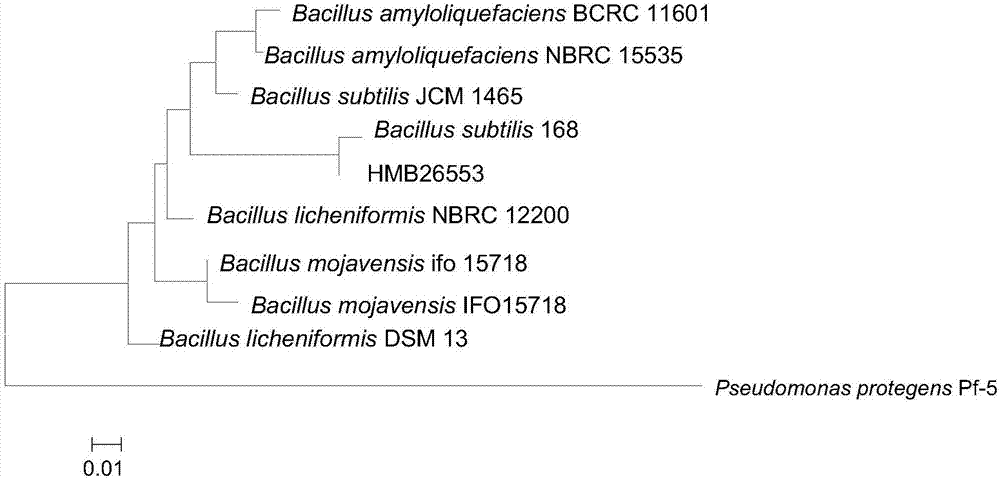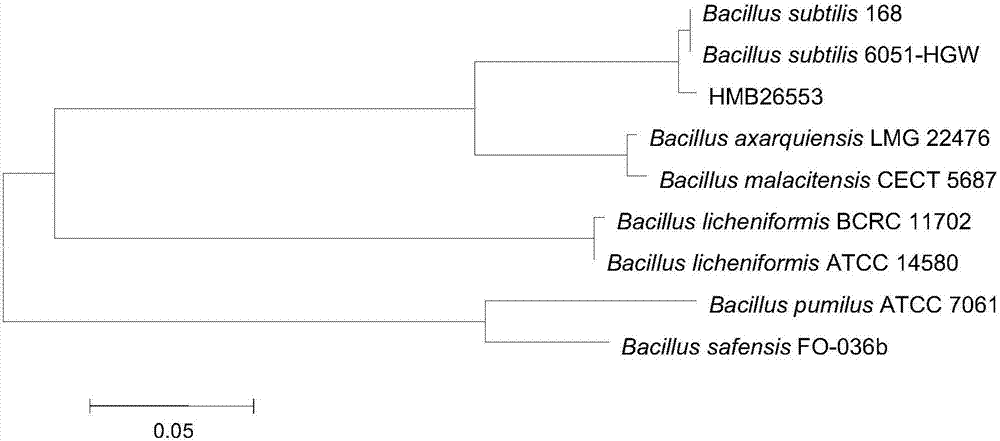Bacillus subtilis HMB26553 and application thereof
A technology of Bacillus subtilis and strains, applied in the field of biological control, can solve the problems of affecting the growth and development of cotton, poor chemical control effect, high drug resistance and cost, and achieve difficult drug resistance, good drug effect persistence, and good inhibitory effect. Effect
- Summary
- Abstract
- Description
- Claims
- Application Information
AI Technical Summary
Problems solved by technology
Method used
Image
Examples
Embodiment 1
[0049] The preparation of embodiment 1HMB26553 microbial bacterial agent
[0050] Proceed as follows:
[0051] (1) Strain activation: Bacillus subtilis (Bacillus subtilis) strain HMB26553 (HMB26553) stored at -80°C was deposited in the General Microbiology Center of China Committee for Microbial Culture Collection on October 28, 2016, and the preservation number is CGMCC No.13211) is activated (30°C) on LB plate medium (its composition and weight ratio are: tryptone 10g, yeast extract 5g, sodium chloride 5g, agar powder 15g, water 1000mL), pick A single colony was cultured at 30°C for 12 hours on LB slant medium (its composition and weight ratio: tryptone 10g, yeast extract 5g, sodium chloride 5g, agar powder 15g, water 1000mL) to obtain activated strains;
[0052] (2) Preparation of seed liquid: make LB liquid medium according to conventional methods (its composition and weight ratio are: tryptone 10g, yeast extract 5g, sodium chloride 5g, water 1000mL), and put it in a 250...
Embodiment 2
[0055] Embodiment 2 HMB26553 bacterial strain of the present invention is to the inhibitory action test of cotton solitaire mycelia growth
[0056] (1) R. solanacearum RH-2 tested: R. solanacearum RH-2 strain was collected from the diseased strain of cotton blight in Qiu County, Handan City, Hebei Province. It was isolated and purified by the Institute of Plant Protection, Hebei Academy of Agriculture and Forestry Sciences. It was identified as Rhizoctonia solani by the Department of Plant Pathology, School of Plant Protection, University, and the pathogenicity test showed strong pathogenicity.
[0057] (2) Test method:
[0058] Plate assay test: first activate and cultivate Rhizoctonia solani RH-2 on a PDA plate for 3 days, and then use a puncher to Punch holes to make bacterial flakes, transfer the flakes of R. solani solanum to the center of another PDA plate, then spot the activated Bacillus subtilis HMB26553 at a place 2.0 cm away from the flakes of the indicator bacter...
Embodiment 3
[0063] Embodiment 3 The comparative test of the control effect of HMB26553 bacterial strain of the present invention to cotton blight
[0064] (1) Test treatment:
[0065] (1) Microbial agent: the HMB26553 liquid preparation prepared in Example 1 was diluted 50 times with water.
[0066] (2) Blank control: clear water
[0067] (2) Test method:
[0068] Mix vermiculite and cotton field soil at a ratio of 1:1, then sterilize at 121°C for 1 hour, and then sterilize again under the same conditions the next day. Inoculate Rhizoctonia solani RH-2 mycelia section suspension (about 10 in 500 gram soils) 7 per milliliter) 10 milliliters, stir evenly, fill in a plastic flower pot with a diameter of 20 cm, and compact it. The cotton variety Jifeng 106 was selected, and the seeds were soaked with the 50-fold water dilution of the HMB26553 liquid preparation prepared in Example 1 for half an hour before sowing; the seeds were soaked in clear water for half an hour as a blank control. ...
PUM
 Login to View More
Login to View More Abstract
Description
Claims
Application Information
 Login to View More
Login to View More - R&D
- Intellectual Property
- Life Sciences
- Materials
- Tech Scout
- Unparalleled Data Quality
- Higher Quality Content
- 60% Fewer Hallucinations
Browse by: Latest US Patents, China's latest patents, Technical Efficacy Thesaurus, Application Domain, Technology Topic, Popular Technical Reports.
© 2025 PatSnap. All rights reserved.Legal|Privacy policy|Modern Slavery Act Transparency Statement|Sitemap|About US| Contact US: help@patsnap.com



